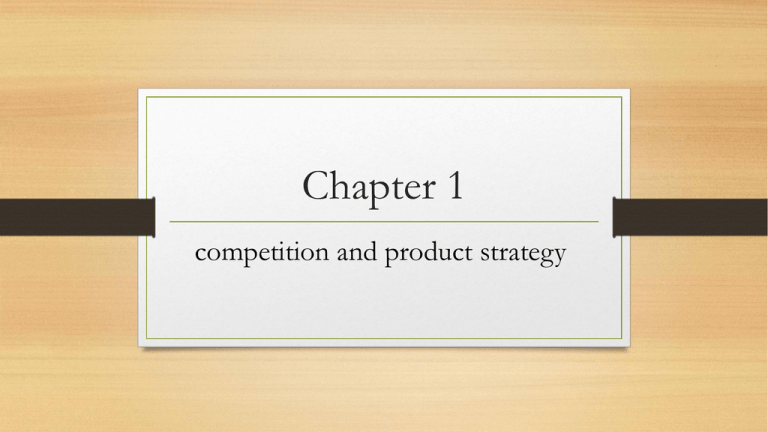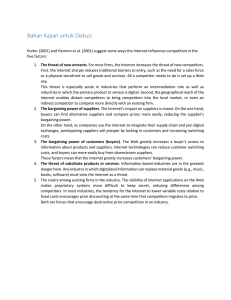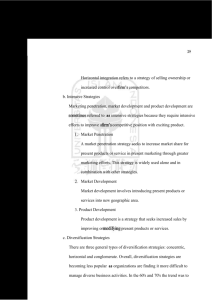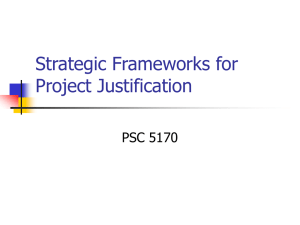Chapter 1
advertisement

Chapter 1 competition and product strategy Objectives • 1- Managing competition: product strategy is central • 2- Product strategy and management • 3- The process of innovation Managing competition: product strategy is central • The economists’ concept of substitutability when the group of firms producing products that are close substitutes for each other. • In order to define the interaction or state of competition between theses firms, economists have developed definitions of a continuum of competitive states ranging from zero ( monopoly) to absolute ( perfect) Managing competition • • • • • • There are five basic forces which govern competition in an industry: 1- The threat of new entrants. 2- The threat of substitution 3- The bargaining power of suppliers. 4- The bargaining power of customer. 5- Rivalry between current competitors. Managing competition • • • • 1- The threat of new entrants Seven major barriers to entry are proposed by Porter: 1- Economies of scale. 2- Product differentiation 3- Capital requirements. • 4- Switching cost. • 5- Access to distribution channels. • 6- Cost disadvantages independent of scale. 7- Government policy Managing competition • 2- The threat of substitution. Substitute products is a matter of searching for other products that can perform the same function as the product of the industry. Managing competition • 3- The bargaining power of suppliers According to porter a supplier group is powerful if the following apply: 1- It is dominated by a few companies and is more concentrated than the industry it sells to. 2- It is not obliged to contend with other substitute products for sale to the industry. 3- The industry is not an important customer of the supplier group. 4- The supplier’s product is an important input to the buyer’s business. Managing competition • 3- The bargaining power of suppliers • 5- The supplier group’s product are differentiated or it has built up switching costs. • 6- The supplier group poses a credible threat of forward integration. • Labor must be recognized as a supplier as well and one that exerts great power in many industries. Managing competition • 4- The bargaining power of customer: • Eight specific condition are proposed by porter where a buying group will exercise power: • 1- The buyer group is concentrated or purchases large volumes to seller. • 2- The products it purchases from the industry represent a significant fraction of the buyer’s costs or purchases. • 3- The products it purchases from the industry are standard or undifferentiated . The bargaining power of customer • • • • 4- It faces few switching cost. 5- It earns low profits 6- Buyers pose a credible threat of backward integration. 7- The industry’s product is unimportant to the quality of the buyers’ products or services. • 8- The buyers has full information. Managing competition • • • • • • 5- Rivalry between current competitors Eight factors: 1- Numerous or equally balanced competitors. 2- Slow industry growth. 3- High fixed or storage costs. 4- Lack of differentiation or switching costs. Rivalry between current competitors • • • • • 5- Capacity augmented large increments. 6- Diverse competitors. 7- High strategic stakes. 8- High exit barriers From this brief summary of the forces which influence competition . It is clear that differ enation is a major source of competitive advantage Strategic options Growth vector matrix New New Market penetration New product development Market development Diversification Strategic options Growth vector matrix • 1- Market penetration: the company seeks increased sales for its present products in its present markets through more aggressive promotion and distribution. • 2- Market development: the company seeks increased sales by taking its present products into new markets. • 3- Product development: the company seeks increased sales by developing improved products for its present markets. • 4- Diversification: the company seeks increased sales by developing new products foe new markets. Strategic options Growth vector matrix • We can notice that the latter two strategies depend on product innovation and the former two on marketing ( process) innovation. Strategic options • Marketing mix strategies: Strategy Product price Distribution Promotion Undifferentiated (cost leadership) Standardizes Low Intensive Mass Differentiated Different for each market segment What the market will bear Extensive Targeted by segment Concentrated (focus) Customized Premium Highly selective Direct Strategic options Marketing mix strategies • The cost leadership is a strategy only available to the largest firms. • Firms with a single product can appeal to a single segment and son are deemed to peruse a strategy of focus. • Medium sized firms have the option of differentiated or concentrated strategy: but the small , single product firm can only pursue a concentrated ( niche) strategy. Strategic options Marketing mix strategies • In markets for undifferentiated products , the market price will determine by the interaction of supply and demand. • Cost leadership is the strategy which seeks to achieve this position and is usually founded on economics of scale and experience curve Product Strategy and Management • • • • • • • Why companies diversify : 1- Survival 2- stability 3- Productive utilization of resources. 4- Adaptation to changing customer needs. 5- Growth 6- Miscellaneous Product Strategy and Management • Product diversification consist of five steps: • 1- A clear definition of objectives. • 2- An analysis of the diversification situation in the light of present operations. • 3- An audit of the tangible and intangible corporate resources for diversification. Product Strategy and Management • 4- Establishment of specific criteria for new products in line with the three preceding points. • 5- A comprehensive search for products and their evaluation against the criteria. • To successful formulation of objectives is to think in terms of what the company can accomplish through use of its resources. Product Strategy and Management • • • • • • Five basic strategies for competing through products: 1- Competing through product proliferation. 2- Competing through Value. 3- Competing through design. 4- Competing through innovation. 5- Competing through services. The Process of Innovation • • • • • • The First- generation innovation process(1950-1960): Basic science Design &engineering Manufacturing Marketing In this stage demand largely outstripped supply. The Second- generation innovation process (1960): Market need Development Manufacturing Sales The perception of innovation shifted towards an emphasis upon demand-side factors. Sales The Process of Innovation • The Third- generation innovation process (1970-1980): • Was a period of demand saturation and high rates of inflation. • Supply capacity out-stripped demand with concomitant structural unemployment. Some of the characteristics were: 1- Focus on cost control and finance. 2- Stress on accounting and finance. 3- Emphasis on success and failure factors. The Process of Innovation • The Fourth- generation innovation process ( 1980-1990): • Started with economic recovery and an initial emphasis on core business and core technology. • This led to recognition of the strategic importance of evolving generic technologies with increased strategic emphasis on technological accumulation. The Process of Innovation • The Fifth- generation innovation process: • The fifth generation model is a logical evaluation of the fourth- generation approach • • • • • • and emphasizes: 1- Technological accumulation. 2- Strategic network. 3- Time to market. 4- Integration of product and manufacturing strategies. 5- Flexibility and adaptability. 6- Quality and responses. The Process of Innovation The Fifth- generation innovation process • • • • • • Time to market has become accepted as a major critical success factors. First mover advantages include: 1- Greater market share. 2- Experience curve benefits. 3- Monopoly profits. 4- Increase customer satisfaction. The Process of Innovation The Fifth- generation innovation process • • • • • In order to implement the fifth- generation model there needs to be: 1- Greater overall organization and system integration: - early supplier involvement in product development. - involvement of leading-edge users in product development. 2- Flatter, more flexible organizational structures for rapid and effective decision making: • -greater empowerment of managers at lower levels. • - empowered project leaders. The Process of Innovation The Fifth- generation innovation process • • • • • • 3- Fully developed internal data bases: - effective data sharing systems. - Expert system. 4- Effective external data link: -co-development with suppliers using CAD system. - effective data kinks with R&D collaborators.






